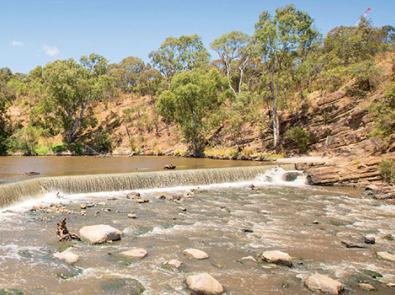Discover the history of Dights Falls, including the importance to the Wurundjeri people – the traditional owners of the area – and the impact of the artificial weir on native fish.
Dights Falls is an artificial weir built on a natural rock bar across the Yarra. It is located on the border of Abbotsford and Clifton Hill, downstream of the junction of the Yarra River with Merri Creek. This is the place where saltwater meets the freshwater flowing downstream in the Yarra River.
Originally, Dights Falls was one of the narrowest parts of the lower Yarra River. This made the Dights Falls site ideal as a camping ground for the Yallock-Bullock clan (Wurundjeri tribe) of the Woiwurrung Aboriginal people. Clans would meet here and trade together.
Before the weir was built, native fish were able to make their way around the natural rock structures and move upstream to breed. Many of these native fish rely on this migration as part of their breeding cycle. This was made difficult with the weir’s construction, but a fishway now allows the fish to move upstream past the artificial barrier.
Download the lesson plan
This lesson plan contains modules explicitly linked to the Victorian Curriculum.
Activities
Activity 1: A history of Dights Falls
Students explore the history of Dights Falls including the importance to the Wurundjeri people, the traditional owners of the area.
Activity 2: How does Dights Falls impact on the river environment?
Students investigate the impacts that the weir construction had on native fish populations and role of the fishway in reducing these impacts.
Victorian curriculum links
- VCGGK105: Classification of environmental resources and the forms that water takes as a resource
Geography > Geographical knowledge > Water in the world - VCGGK106: Ways that flows of water connect places as they move through the environment and the ways this affects places
Geography > Geographical knowledge > Water in the world - VCGGK109: The spiritual, cultural and aesthetic value of landscapes and landforms for people, including Aboriginal and Torres Strait Islander peoples, that influence the significance of places, and ways of protecting significant landscapes
Geography > Geographical knowledge > Water in the world
